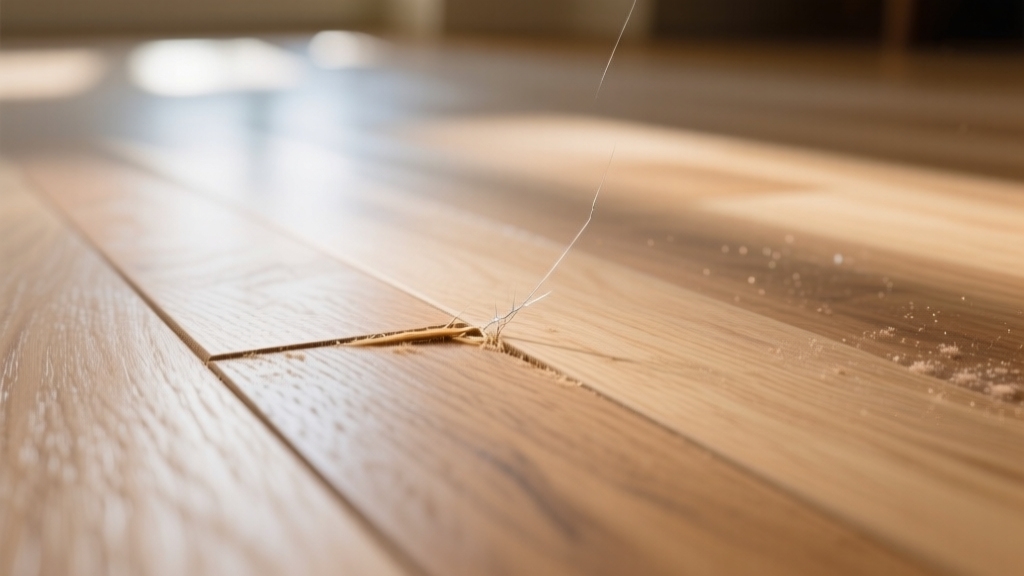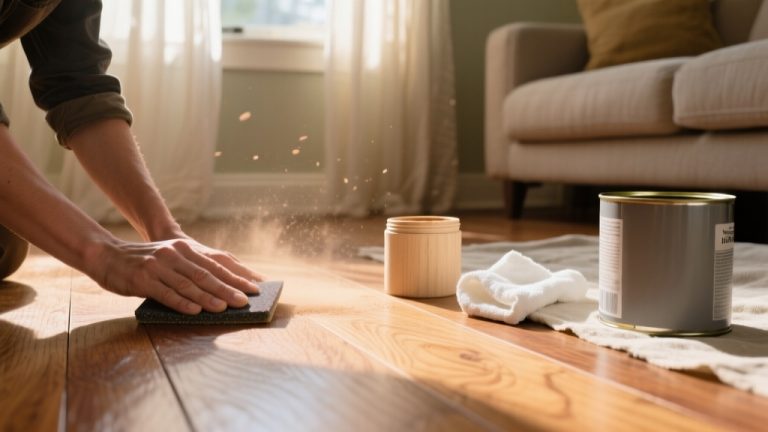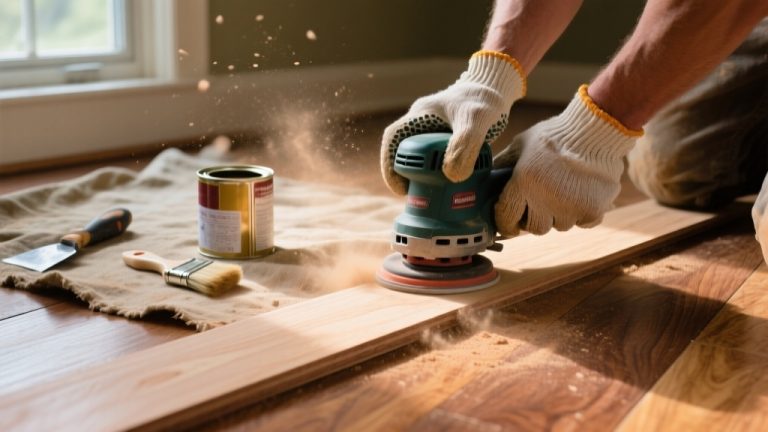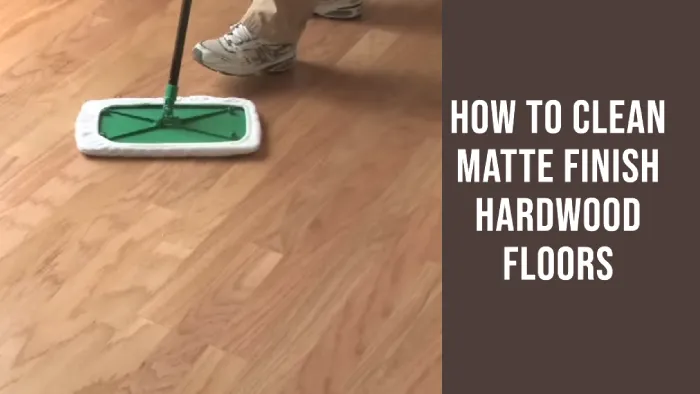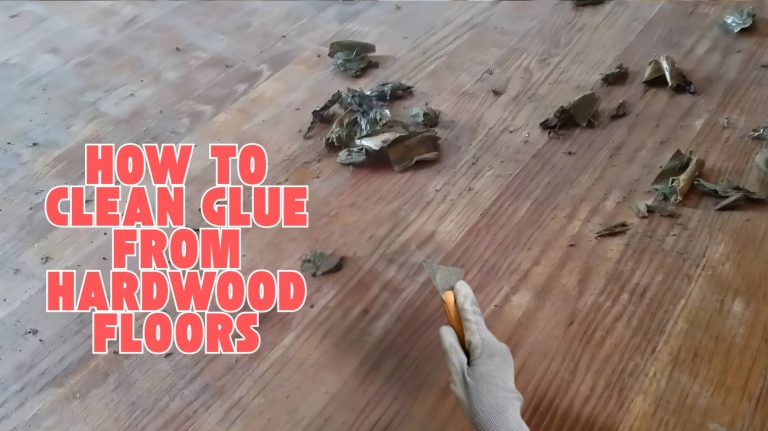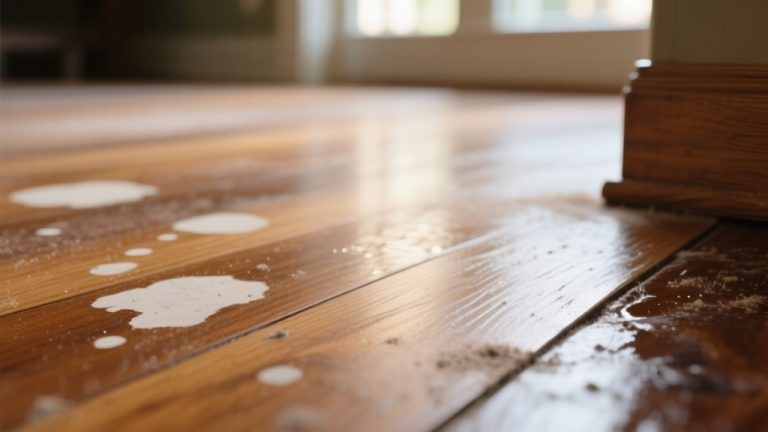Does Engineered Hardwood Scratch: Protecting Floor’s Beauty
Yes, engineered hardwood can scratch, but its resistance depends on factors like wood species hardness, wear layer thickness, and finish quality. Harder woods and factory-applied aluminum oxide finishes offer better protection, while thicker wear layers allow more refinishing cycles to maintain durability.
Environmental conditions and foot traffic also affect scratch visibility. With proper maintenance and repair techniques, you can minimize and address scratches effectively. Understanding these elements will help you protect and prolong your flooring’s appearance.
Key Takeaways
- Engineered hardwood can scratch, but its aluminum oxide finish often provides a durable, scratch-resistant surface.
- Pet nails, heavy foot traffic, and abrasive debris increase the risk of scratches on engineered hardwood floors.
- Thicker wear layers and quality finishes improve engineered hardwood’s resistance to surface scratches and dents.
- Proper maintenance, including regular cleaning and use of furniture pads, helps minimize scratch damage on engineered hardwood.
- Engineered hardwood is more dimensionally stable than solid wood but still requires humidity control to prevent surface stress and scratches.
Understanding Scratch Susceptibility in Engineered Hardwood
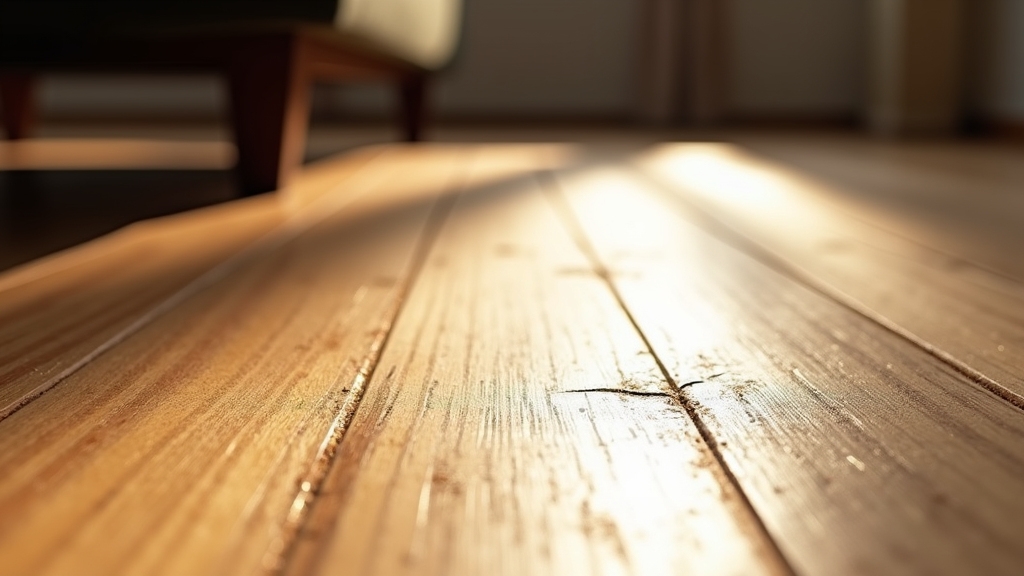
While wood species hardness plays a role, scratch susceptibility in engineered hardwood depends more on factors like finish type and wear layer thickness. You’ll find that finishes such as aluminum oxide penetrate and seal the surface, forming a durable, scratch-resistant barrier.
This protective layer is especially important in high-traffic areas to maintain the floor’s appearance over time. Additionally, proper floor finishing techniques help ensure the protective coating remains intact and effective.
Thicker wear layers—typically 2 to 4 mm—allow you to sand and refinish the floor multiple times, repairing deeper scratches. The multilayer construction adds dimensional stability but doesn’t inherently improve scratch resistance.
Softer finishes or wax coatings reduce abrasion resistance, making scratches more likely. You should also consider maintenance and environmental factors, like humidity control, which affect how scratches develop and worsen.
How Wood Species Hardness Affects Scratch Resistance?
Because wood species hardness directly impacts scratch resistance, selecting the right hardwood for engineered flooring is essential. Higher Janka hardness ratings generally mean better resistance to scratches and dents.
For instance, hickory (1,820 Janka) offers strong scratch resistance, making it ideal for busy households. Hickory also naturally hides minor scratches due to its distinctive grain patterns, enhancing its durability in active environments.
Choosing hardwood with a high Janka rating like hickory ensures better scratch resistance for engineered flooring.
Exotic species like Brazilian cherry (approx. 2,350 Janka) provide even greater durability. However, hardness alone doesn’t guarantee abrasion resistance; white oak, although softer (1,360 Janka), resists wear well due to its density and tight grain structure.
Regular maintenance methods such as proper cleaning and care further protect the floor’s surface from damage. You should also consider grain patterns—denser and tighter grains reduce visible scratches. Softwoods like pine (690 Janka) are more prone to damage.
Importance of Wear Layer Thickness in Durability
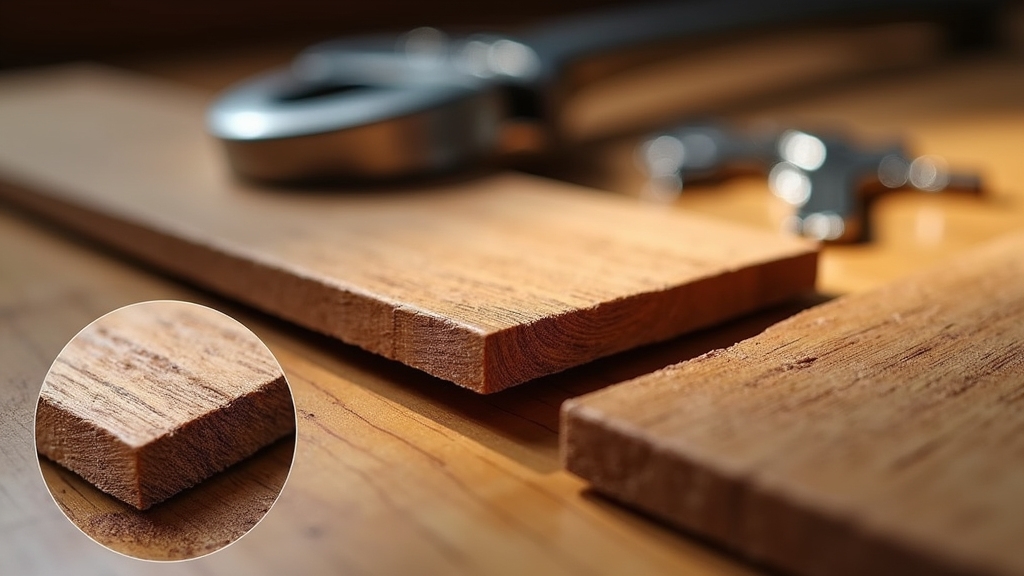
You’ll find that wear layer thickness directly influences scratch resistance and overall durability in engineered hardwood. Thicker wear layers not only absorb daily impacts better but also allow multiple refinishing cycles.
Sanding removes about 1mm of hardwood per session, so a thicker wear layer means more opportunities to refresh your floor’s surface over time. This extends your floor’s lifespan. Additionally, multiple layers provide added stability and impact resistance, enhancing durability.
Wear Layer Thickness Benefits
When selecting engineered hardwood flooring, understanding wear layer thickness is essential for ensuring long-term durability. A thicker wear layer, typically 5-6 mm, offers superior resistance to scratches, dents, and heavy foot traffic, maintaining floor integrity longer than thinner layers.
The wear layer’s quality significantly affects the overall longevity and performance of the flooring, making it a critical factor to consider. It also enhances dimensional stability, reducing risks of warping from humidity and temperature changes.
Proper cleaning and maintenance, including using suitable products like Swiffer Sweeper designed for hardwood floors, can help preserve this durability. Beyond durability, a thick wear layer allows multiple refinishes—up to five times—extending the floor’s lifespan considerably. In contrast, thinner layers limit refinishing options and wear out faster.
For high-traffic areas, choosing flooring with a robust wear layer means better performance and a longer-lasting surface. This investment in durability and performance often results in cost savings over time due to reduced replacement needs.
Scratch Resistance Impact
Understanding wear layer thickness sets the stage for evaluating how it influences scratch resistance in engineered hardwood. While thickness ranges from 1mm to 4mm, it doesn’t directly determine scratch resistance. Instead, the finish applied to the wear layer plays a pivotal role.
Consider these factors:
- A hard, factory-applied finish like aluminum oxide greatly enhances scratch and stain resistance.
- Thicker wear layers permit multiple refinishing cycles but don’t improve daily scratch resilience. Proper maintenance and avoiding excessive mopping help preserve the finish integrity.
- Hard wood species (e.g., oak, hickory) resist scratches better than softer ones like pine.
- Core construction stability maintains a flat, undamaged surface, indirectly supporting scratch resistance.
- Most prefinished floors have an aluminum oxide finish that lasts the lifetime of the floor, providing consistent protection.
Refinishing and Longevity
Although wear layer thickness doesn’t directly affect daily scratch resistance, it plays a crucial role in your engineered hardwood’s refinishing potential and overall longevity. Wear layers of 3mm or more allow multiple sanding cycles, extending your floor’s lifespan notably.
Additionally, the core construction beneath the wear layer significantly influences the floor’s resistance to warping and cupping, which impacts long-term durability. Proper sanding techniques are essential to avoid over-sanding, which can damage the thin veneer and underlying layers.
Thinner layers, around 2mm, limit refinishing options, often requiring replacement once worn. Floors with 4mm to 6mm layers suit high-traffic areas, enabling frequent refinishing to maintain appearance and durability.
Thicker wear layers also support more aggressive finishes like aluminum oxide, enhancing surface hardness. Remember, your floor’s lifespan depends on wear layer thickness combined with core stability and finish quality.
Investing in thicker wear layers ensures your engineered hardwood withstands wear, allows maintenance through refinishing, and delays costly replacements. Following manufacturer guidelines and professional advice is critical to safely sanding and refinishing engineered hardwood floors.
Influence of Finishes and Coatings on Scratch Protection
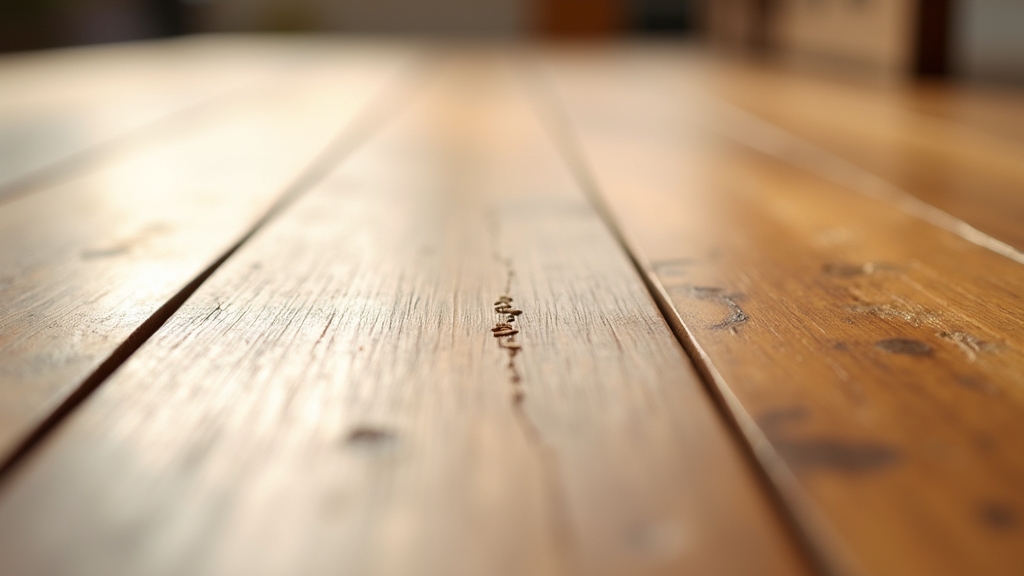
Since scratch protection largely depends on the finish applied, selecting the right coating is essential for engineered hardwood durability. Aluminum oxide finishes create a hard, protective barrier that resists scratches effectively, especially when factory-applied for consistency. This finish also helps in maintaining the floor’s natural beauty by protecting the wood grain beneath.
Urethane finishes combined with aluminum oxide also offer strong resistance, while oil finishes prioritize natural appearance over surface protection. Additionally, floors with thicker top layers allow for more extensive refinishing and can better remove deep scratches, enhancing long-term durability.
Additionally, finish sheen impacts scratch visibility; matte finishes conceal minor imperfections better than high-gloss. Consider these factors to optimize scratch protection:
- Use thicker top layers to allow refinishing and deeper scratch removal
- Choose hardwood species with higher Janka hardness ratings
- Opt for textured finishes to mask surface damage visually
- Select multi-layered, aluminum oxide-enhanced coatings for maximum durability
Environmental Factors That Impact Surface Integrity
You need to monitor humidity levels closely, as fluctuations cause engineered hardwood to expand or contract, risking surface warping and damage. It is important to maintain proper installation and follow manufacturer guidelines to ensure long-term performance.
High foot traffic and pets introduce abrasive particles that scratch and wear down the finish over time. Implementing humidity control and protective measures can markedly extend your flooring’s lifespan and durability.
Humidity Effects on Flooring
When humidity levels shift, engineered hardwood responds by expanding or contracting due to moisture absorption and release within its layered structure. Though engineered hardwood is more dimensionally stable than solid wood, fluctuating moisture still causes subtle movement that can affect surface integrity.
You need to maintain indoor relative humidity between 30% and 50% to minimize risks. Proper installation practices, including leaving an expansion gap, help accommodate this natural movement and prevent damage.
If humidity falls below 25%, wood dries excessively, leading to cracking and splitting. Above 60%, swelling and cupping occur. Key points to contemplate include:
- Engineered hardwood’s plywood layers restrict drastic swelling or shrinking.
- Repeated humidity changes can cause micro-cracks and adhesive failure.
- Proper acclimation before installation reduces moisture-induced stress.
- HVAC humidity control stabilizes flooring conditions in variable climates.
- The multi-layer construction of engineered hardwood provides greater structural stability than solid wood, helping it better withstand humidity fluctuations.
Traffic and Pet Impact
Although engineered hardwood is designed for durability, high foot traffic and active pets substantially impact its surface integrity through scratches and dents. Dirt and small gravel tracked in on shoes act as abrasives, accelerating surface wear, especially in entryways and hallways.
Proper cleaning and maintenance, including thorough removal of debris, are essential to reduce uneven wear and prolong floor life. Heavy furniture movement without protective pads also contributes to dents. Pet nails, particularly from larger or multiple pets, create significant scratching, while their activity increases surface stress.
The wear layer thickness of engineered hardwood determines how many times it can be refinished to restore surface integrity. Selecting hardwoods with higher Janka hardness, like maple or hickory, combined with scratch-resistant finishes, improves resilience.
To mitigate damage, regularly sweep or vacuum to remove debris, use area rugs in high-traffic zones, trim pet nails, and apply felt pads under furniture. Additionally, applying a protective polyurethane finish can enhance durability and help maintain an even surface appearance.
Everyday Usage and Its Effect on Engineered Hardwood Scratches
Since engineered hardwood features a real wood veneer, it reacts to everyday use much like solid hardwood, making it susceptible to scratches from common household activities. The extent of scratching depends on the wood species’ hardness, surface finish, and wear layer thickness.
You’ll notice that softer woods like Cherry scratch more easily than harder species like Oak or Hickory. Common causes include moving furniture without protection, pet claws frequently contacting the floor, dropped objects striking the surface, and dirt and sand particles underfoot increasing abrasion.
Regular vacuuming with attachments can help reduce particles that cause scratches. A durable finish, especially aluminum oxide-based, provides a protective barrier but won’t eliminate scratches entirely. This finish is known for its scratch-resistant layer that helps protect floors in active households.
Maintaining a thicker wear layer also improves resistance and allows refinishing to manage surface damage, extending the floor’s functional lifespan under routine use.
Effective Techniques for Repairing Minor Scratches
You can effectively repair minor scratches on engineered hardwood by carefully buffing the surface along the wood grain to smooth out finish imperfections. This method works well for surface scratches that only affect the finish layer.
For deeper surface marks, applying a color-matched wax repair kit fills and conceals scratches without damaging the wear layer. When scratches penetrate the finish, refinishing the wear layer restores protection and a uniform appearance.
Buffing Methods
When repairing minor scratches on engineered hardwood, preparing the surface and selecting the right tools are essential for effective buffing. First, clear the workspace by removing furniture and rugs, then clean the floor with a hardwood floor cleaner to eliminate dirt.
Buffing is effective only for scratches that do not penetrate the wood and affect just the finish superficial damage. Use a rental floor buffer equipped with 120-150 grit screening pads for light scratch removal, applying steady, overlapping strokes along the wood grain. Remember, avoid heavy pressure to protect the veneer layer.
Follow these steps for best results:
- Use fine-grit sandpaper to gently smooth scratches before buffing.
- Thoroughly clean dust with a tack cloth to prevent embedding grit.
- Wear safety gear like dust masks and gloves during the process.
- After buffing, apply hardwood floor polish with a wet edge technique to restore shine and protection.
Wax Repair Kits
Buffing can diminish the appearance of minor scratches, but for surface-level imperfections that still show, wax repair kits offer a targeted solution. These kits, stocked at most hardware stores, include multiple wax shades to help you match your floor’s color precisely.
Start by cleaning the scratch thoroughly to remove dirt and oils, ensuring good wax adhesion. Use a plastic putty knife to press wax into the scratch, filling it completely. Remove excess wax immediately with a damp, lint-free cloth for a smooth finish. Because engineered hardwood floors often have a surface coating that protects against scratches, the wax repair can blend well with the existing finish.
For best results, blend wax colors if needed and test on an inconspicuous spot first. Remember, wax kits only mask superficial scratches; deep gouges require more extensive repair. Regular maintenance prevents buildup and keeps repairs subtle.
Refinishing Wear Layers
Although minor scratches on engineered hardwood often affect only the finish layer, addressing them promptly with sanding and refinishing guarantees lasting protection and appearance.
Start by sanding lightly with fine-grit sandpaper, moving with the grain to avoid damaging the veneer. Remove dust with a tack cloth before applying the original finish product to restore protection. Multiple coats may be necessary for seamless blending.
Consider these key steps:
- Sand gently to avoid veneer damage, focusing only on shallow scratches.
- Use color-matched wood fillers for moderate scratches, then sand and seal.
- Apply compatible stains cautiously for color correction and blending.
- Retain some original finish for quick spot repairs.
- Before beginning, clean the scratch area thoroughly to ensure the repair materials adhere properly.
Maintenance Practices to Minimize Scratch Damage
Since engineered hardwood floors are prone to scratches from daily wear, you must implement consistent maintenance practices to protect their surface. Regularly sweep or vacuum using hardwood-appropriate tools to remove abrasive dirt.
Damp-mop with a microfiber cloth and use cleaners designed for engineered wood to avoid residue buildup. Daily sweeping in high-traffic areas with a soft-bristled broom is essential to prevent scratches and scuffs.
Place felt pads under furniture legs and use rugs at entryways to minimize physical damage. Trim pet nails and avoid dragging heavy items to reduce gouges. Control indoor humidity around 45% with humidifiers or dehumidifiers to prevent warping.
Choose floors with durable finishes like aluminum oxide, and recoat every 3–5 years to maintain scratch resistance. Routinely inspect for damage, promptly repair minor scratches, and consult professionals for extensive wear.
Comparing Engineered Hardwood With Solid Hardwood on Scratch Resistance
When evaluating scratch resistance between engineered and solid hardwood floors, you’ll find that the protective finish and wood species play crucial roles. Both types use real hardwood veneers, so scratch susceptibility depends more on the species hardness than construction.
Engineered hardwood often sports advanced finishes like aluminum oxide, boosting resistance beyond some solid hardwoods. However, solid hardwood’s full thickness allows multiple refinishing cycles, extending scratch protection over time.
The protective finishes applied to engineered hardwood, such as polyurethane or aluminum oxide, significantly enhance its durability and scratch resistance. Key factors to contemplate include:
- Wood species hardness (oak, maple, hickory resist scratches better than pine or walnut)
- Protective finish quality (polyurethane or aluminum oxide enhances durability)
- Wear layer thickness in engineered hardwood (thicker layers improve longevity and refinishing potential)
- Dimensional stability (engineered hardwood’s stable core reduces moisture-related damage that can cause scratches)
Tips for Selecting Scratch-Resistant Engineered Hardwood Flooring
Understanding how wood species, finishes, and construction impact scratch resistance helps you make informed choices when selecting engineered hardwood flooring.
Opt for hardwoods like hickory, white oak, or European oak, which offer high Janka hardness and durability. Maple is also suitable for high-traffic areas, while walnut requires a robust finish for scratch resistance.
Select aluminum oxide or polyurethane finishes enhanced with ceramic or diamond additives to maximize surface protection. Matte or satin sheens better conceal scratches than glossy ones.
Prioritize thicker wear layers and multi-ply cores to improve stability and allow refinishing. A thicker wear layer also allows for more frequent sanding, significantly extending the floor’s lifespan.
Consider UV-cured coatings and anti-scratch treatments for added durability. Finally, maintain your floor by preventing dirt buildup and using protective pads, ensuring your engineered hardwood retains its scratch-resistant properties over time.
Frequently Asked Questions
Can Engineered Hardwood Scratches Be Covered With Area Rugs Without Causing Damage?
Yes, you can cover engineered hardwood scratches with area rugs without causing damage, but you need to choose rugs carefully. Use rugs with breathable, non-abrasive backings and proper hardwood rug pads to prevent slipping and scratching.
Regularly lift rugs to clean underneath and allow airflow. This helps avoid moisture buildup and dirt accumulation. This approach protects your floor while hiding scratches, preserving the hardwood’s finish and structural integrity effectively.
Are Scratch-Resistant Engineered Hardwood Floors Pet-Friendly?
Yes, scratch-resistant engineered hardwood floors are pet-friendly. You’ll want to choose harder wood species like hickory or maple and finishes with aluminum oxide for maximum protection against claws.
Matte or satin finishes help hide minor scratches, while thicker wear layers allow for refinishing when needed. Regular maintenance and quick cleanup of pet messes will prolong your floor’s durability and appearance, making these floors practical for homes with pets.
How Does Humidity Control Affect Scratch Repair Longevity on Engineered Hardwood?
Humidity control directly impacts scratch repair longevity on your engineered hardwood by stabilizing wood movement. When you keep indoor humidity steady between 35% and 55%, you prevent expansion and contraction that stress repair materials.
Without this control, fillers and finishes can crack or peel prematurely. Using humidifiers or dehumidifiers, acclimating floors before installation, and applying moisture-resistant finishes help guarantee your repairs stay intact and durable over time.
Is Professional Scratch Repair More Effective Than DIY Methods for Engineered Hardwood?
Yes, professional scratch repair is more effective for engineered hardwood. You’ll benefit from precise stain matching, controlled sanding, and durable finish applications that blend repairs seamlessly. Professionals address deep scratches and structural issues, ensuring long-lasting results and maintaining floor warranties.
While DIY fixes might conceal minor damage temporarily, they often lack durability and uniformity, risking uneven surfaces and quicker wear. Choosing experts saves you time and preserves your floor’s integrity efficiently.
Do Warranties Cover Damage From Accidental Scratches on Engineered Hardwood Floors?
Think of your warranty as a shield with a small crack. It protects structural flaws but not surface scratches. You won’t find coverage for accidental scratches on engineered hardwood floors since manufacturers classify them as normal wear and tear.
Even if you follow all maintenance rules, warranties exclude damage like scuffs, dents, or finish wear caused by accidents, pets, or improper use.
Smart Maintenance to Keep Engineered Hardwood Floors Looking New
While engineered hardwood may occasionally show subtle signs of everyday life, its carefully crafted layers and protective finishes work together to keep your floors looking resilient. By choosing the right wood species, wear layer thickness, and maintaining proper care, you can confidently minimize surface blemishes.
Embracing these strategies guarantees your flooring remains a durable, attractive foundation in your space, balancing beauty with practical longevity.

